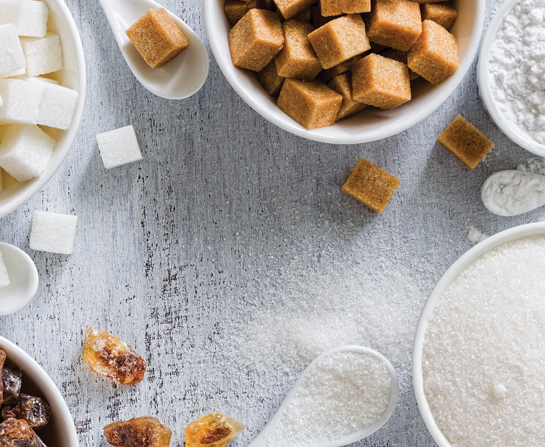Of Sugar and Substitutes
May 1, 2022 Return

Sugar is an inseparable ingredient in the food we consume. However, too much sugar is not ideal for our health and teeth. Hence, sugar substitutes continue to entice consumers. Generally, any sweeteners other than the regular table sugar are considered as sugar substitutes. Table 1 shows several types of sugar substitutes available currently.
Sugar substitutes | Examples | Definition | Uses | Concerns |
|---|---|---|---|---|
Artificial sweeteners |
|
|
|
|
Sugar alcohols |
|
|
|
|
Novel sweeteners |
|
|
|
|
Natural sweeteners |
|
|
|
|
Sweetener | Caloric value (kcal/g) | Date approved | ADI | Number of times sweeter than sucrose |
|---|---|---|---|---|
Acesulfame potassium | 0 | 1988 | Approved as food additive 15mg/ kg body weight/day | 200 |
Aspartame | 4 | 1981 | Approved as food additive 50mg/ kg body weight/ day | 180 |
Neotame | 0 | 2002 | Approved as food additive 18mg/person/day | 7000 |
Saccharin | 0 | In use before the Food Additives Amendment of 1958 | Permitted for use under an interim regulation | 300 |
Sucralose | 0 | 1998 | Approved as food additive 5mg/ kg body weight/ day | 300 |
Note: ADI= Acceptable daily intake established by the U.S. Food and Drug Administration.
Although Aspartame provides 4 kcal/g, the amount of Aspartame used in food and drinks is so little that its calorie contribution is negligible.
Health benefits
Dental care
Sugar substitutes, unlike sugar, do not promote the development of dental caries. The microflora of dental plaque produces little or no decay-promoting acid in reaction to sugar substitutes.
Weight loss
Most sugar substitutes are lower in calories than sugar is. Substituting regular sugar (4 kcal/ g) with other sugar subsitutes (lower in calories than regular sugar) allows individuals to consume the same food they normally would, with a lower calorie intake. For instance, most of the generally used sugar alcohols provide lower calories, as follows:
- Erythritol 0.2 kcal/g
- Isomalt 2.0 kcal/g
- Lactitol 2.0 kcal/g
- Maltitol 2.1 kcal/g
- Mannitol 1.6 kcal/g
- Sorbitol 2.6 kcal/g
- Xylitol 2.4 kcal/g
Diabetes mellitus
Most sugar substitutes are metabolised more slowly, allowing blood sugar levels to stabilised over time. Hence, they may be beneficial for patients with diabetes mellitus.

In conclusion, sugar substitutes should be used only in moderation. Sugar substitutes, as their name implies, are simply to substitute one addiction (regular sugar) with another. That being said, you may train your taste buds to enjoy less sweet food over time. By progressively reducing the quantity of sugar you consume, you may alter the way your taste buds perceive food. For instance, you may cut down the quantity of sugar in your morning coffee or tea, from 1 teaspoon to ½ teaspoon.
References:
Manfred Kroger, Kathleen Meister and Ruth Kava. (2006). Low calorie sweeteners and other sugar substitutes: A review of the safety issues. Comprehensive Reviews in Food Science and Food Safety, Vol. 5, 35-47.
Kritida R. Tandel. (2011). Sugar substitutes: Health controversies over perceived benefits. J Pharmacol Pharmacother., 2(4), 236-243.
U.S. Food and Drug Administration. (2001). Agency response letter. GRAS Notice No. GRN 000045. 5 Oct. Rockville, Md.: USFDA.
McNutt K. (2000). What clients need to know about sugar replacers? J Am Diet Assoc., 100, 466-469.
If you like this article, do subscribe here.
